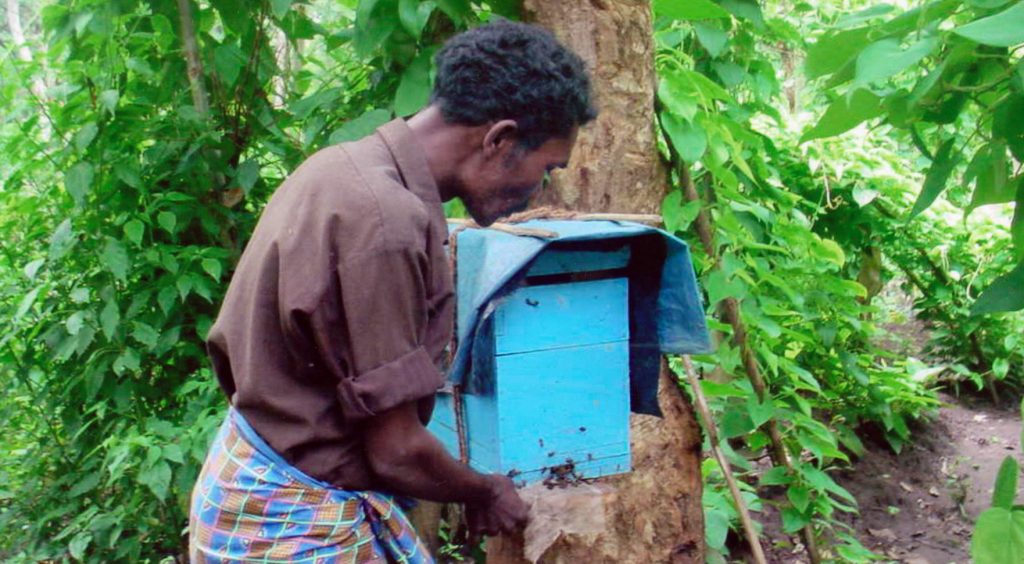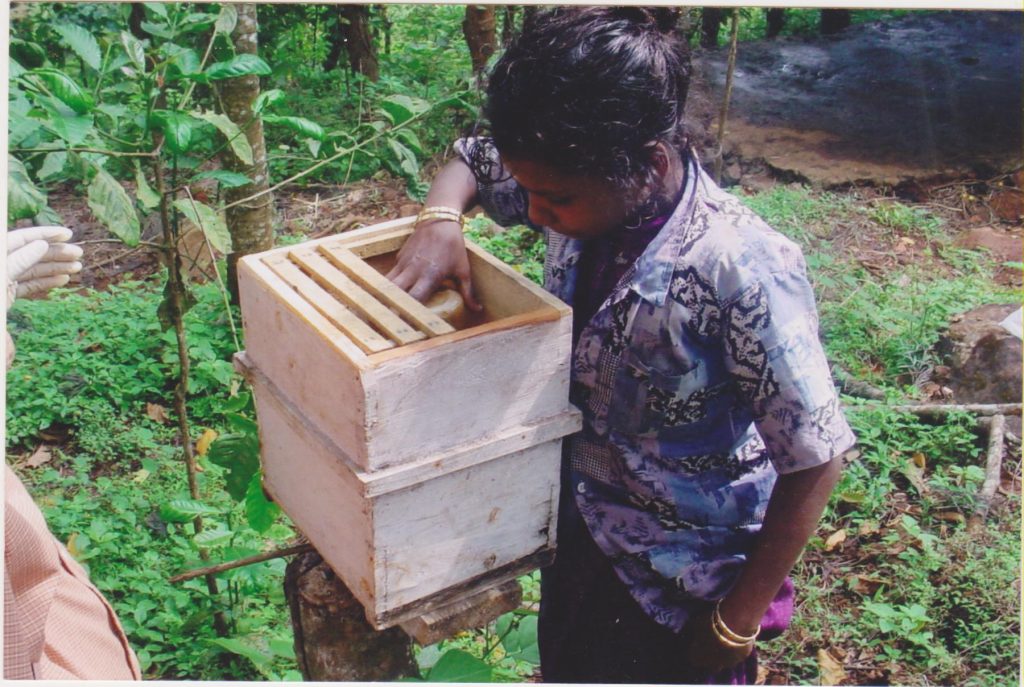
The Kattunaikka are expert honey tasters and will link the distinct tastes to specific forest flowers. Theyclassify different types of honey according to the type of bees and the nature of hives from which they are collected. They canrecognize five types of ‘Jen’ which vary greatly in taste and therapeutic properties: These are Kombujen/DaddanJen,Thudajen, Gandajen/Dojjan, Nasarjen/Kothukujen,and Kusumbujen/Cherujen. Owing to their skills in Wild Honey collection, classfication and maintenance, theKattunaikka are also known by nameJenukkurumba.‘Jen’ is the Kattunaikkaword for honey.
The bulk of the honeycomes from hives seen in the branches of tall treesor rock crevices (Kombujen-more than 25kg/hive).The bees that produce this honey are larger in sizeand yellowish in colour (Vijayan, Ponkuzhy,Kattunaikka colony). Honey is also differentiatedbased on the season of availability, as Kannijenwhich is available in bulk during Kannimasam(Sept.-Oct.) and Karthijen which is available inKarkkidakam (July). The availability and quality ofhoney is based on the flowering of forest trees in thelocality. Flowering of Venthekku (Lagerstromealanceolata) signals abundant availability ofKombujen.Some of the forest trees that bloomduring the rainy months could make the Kombujentoxic and might cause vomiting if consumed.
The hives of Thudaijen/Pothujen are mainly seenin tree crevices or in inactive white ants’ pits. Thecolor of the honey is reddish brown and itsavailability is usually based on the flowering ofMattimaram (Terminalia tomentosa). TheJenukkurumbas are experts in inducing the small beesof the Melipona species to hive in bamboo stems,to get an almost ‘captive supply’ of the deliciousCherujen. Cherujen is the most precious of thevarious varieties of honey, sparsely produced,difficult to extract and believed to possess excellentnutritional and medicinal attributes. It is available round the year. Raghavan of AranamalaKattunaikkacolony informed us that the taste of the honey storedin the different chambers of a single hive of this beetend to be different as the bees fill the honey sourcedfrom different flowers separately in variouschambers. Kedujen/Kothukujen is mainly seenon dry branches of bushy plants and the bees arecomparatively smaller.
The nutritional value of honey is widely known tothe men and women of all the communities studied.The Kattunaikka and hill Paniya communitiespossess a wealth of knowledge about the nutritionaland therapeutic value of honey. In the past, thesetwo communities habitually consumed a great dealof honey and it was undoubtedly an importantcontributory factor to their health and food security.Many of the Kattunaikka men and women told usabout how regular consumption of honey, tubers andwild meat ensured their health and well-being.Today, honey has been catapulted to the position ofone of the most important non-wood forest producereaching the market.
Kattunaikka women take special interest incollecting Cheruthen, as it is believed to be highlynutritious and medicinal and is best suited forinfants. It was never a practice in the past to sell thisvariety of honey, considered to be very rare andhighly nutritious. It is usually found in small rockcrevices, on the walls of old bamboo houses, fencesand on branches of plants like coffee or teak, whichare within easy reach. The collection of this type ofhoney involves much labour and a great deal ofpatience, and men normally avoid the task. Thehoneybees in this case are tiny and tend to stickinvariably on the collector’s hands and often timesall over the body. Removing them is a messy andpainful job. Moreover, as Cheruthen is produced inminimal quantities, yielding sufficient quantitiesinvolve locating several hives to extract it from. Thisis another dampener on men’s enthusiasm to sourcethis variety of honey. Women in general, on the otherhand, ensure that small crevices, old bamboo walls,etc. where these bees nestle are preserved.

The availability of honey at different times in thewet and dry zones of Wayanad district could be due toseasonal variations in the flowering of trees. In wetzone forests, most of the trees flower during winterand summer and in the dry area, the trees flowerduring or just before the monsoon.
(As reported by Dr. Ratheesh Narayanan & Anil Kumar 2012)
